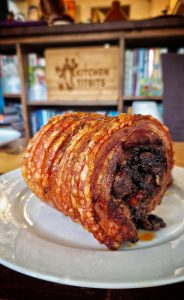
For the stuffing, you need raw cooking chorizo, not the cured variety and if you can get hold of Spanish black pudding (morcilla) it is truly worth it. It is made in a similar way to British black pudding but uses different spices, rice instead of oatmeal and sometimes fruit, such as blackberries, to give it quite a distinctive flavour and a softer texture to ours. I used Brindisa morcilla which I was able to buy in Papadeli in Bristol. Brindisa and Papadeli both have online shops so if you’re unable to find it close to home, try there.
If you don’t like black pudding, I urge you to still try the stuffing with the black pudding in it. The flavours and textures combine in such a way that you aren’t able to taste the black pudding on its own. If you’re still not convinced, leave the black pudding out and use an extra chorizo instead.
Serves 4
Ingredients
1 kg boned belly pork, with the fat scored
3 chorizo picante
2 morcilla or 1/4 British black pudding
150g sausage meat
3 – 4 slices of bread made into bread crumbs
1 onion, finely chopped
2 cloves garlic, finely chopped or crushed
8 sprigs fresh thyme, leaves stripped from the stalks
2 tsp Spanish sweet smoked paprika
1 egg beaten
1/2 tsp fennel seeds
3 tbsp olive oil
1 bulb smoked garlic (or normal garlic if you can’t get smoked)
100ml dry white wine
300ml chicken stock (if I haven’t got fresh, I use Knorr concentrated chicken stock in a bottle and water)
2 tsp cornflour
salt and pepper
Method
- First make the stuffing. Gently fry the onions in a tablespoon of olive oil until they are soft and translucent. You don’t want them to brown so fry them slowly over a low heat.
- Once the onions are cooked, add the garlic and cook for a few minutes until there is no longer a strong smell of raw garlic.
- Turn off the heat and allow the onions and garlic too cool completely.
- Remove the chorizo and black pudding from their skins and put the meat in a bowl.
- Add the sausage meat and most of the breadcrumbs to the chorizo and black pudding mixture.
- Then add most of the thyme leaves, 1 tsp paprika, some of the egg, a little salt and a good grinding of pepper.
- Once the onion and garlic has cooled tip this into the stuffing mixture and get stuck in with your hands.
- If the mixture is too wet and won’t come together you’ll need to add more breadcrumbs. If it’s too dry you will need to add a little more egg to bind it.
- Now make the rub. Pour the remaining oil into a small bowl or mug, add the rest of the thyme leaves and paprika and season with salt and pepper.
- Crush the fennel seeds and add to the rub mixture. Mix together with a spoon and set to one side.
- Next stuff the pork. With the belly pork laying skin/fat side down, take about a third of the stuffing mixture and lay it in a line down the middle of the pork.
- Roll the pork and tie with string.
- Lay in a roasting tray and pour over the rub mixture. Using your hands, rub the mixture all over the pork and into the slits in the pork fat.
- Leave to marinade for 30 minutes or a few hours if you have the time.
- Use the rest of the stuffing mixture to make little balls which you can cook alongside the pork.
- Pre-heat the oven to 240C.
- Cook the pork for 25 minutes at 240C before turning the oven down to 190C and cooking for a further 45 minutes.
- Break the bulb of garlic into cloves (but don’t peel) and lay in the tray around the pork. Pour 100ml of water into the tray and turn the oven down to 150C before cooking for another hour.
- Put the balls of stuffing on a tray and put in the oven.
- By now the pork should be cooked but you can check by sticking a knife into the meat and pulling it out. If the meat juices are clear with no sign of pink, it is cooked. If the juices are pink with blood you’ll need to cook the pork for a little longer.
- Remove the pork and garlic from the tray and leave the meat to rest for about 15 minutes.
- If the stuffing balls aren’t brown, you can turn the oven back up to 220C and cook for a little longer whilst the meat rests and you make the gravy.
- Pour off most of the fat from the roasting tray then place the tray on a high heat on the hob.
- Pour in the wine and using a wooden spoon scrape around the tray to pick up the really tasty sticky bits.
- Pour in the stock or 1tbsp concentrated chicken stock and 300ml water. Stir and bring to the boil.
- Mix the cornflour with a tablespoon of cold water and gradually pour into the gravy whilst stirring. The gravy will thicken slightly. If it’s too thick add a little extra water.
- Taste for seasoning. Add a little salt and/or pepper if you think it needs it.
- Carve the meat into slices and place on a serving tray. Put the stuffing balls and garlic around the meat and pour the gravy into a jug.